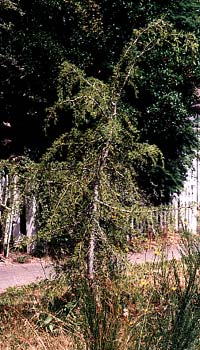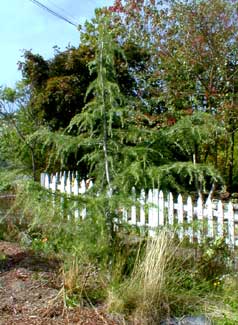
Contorted
Deodar
Cedar
"These two fair cedar-branches
The noblest of the mountain where they grew,
Straightest & tallest, under whose still shades
The worthier beasts have made their lairs, & slept."
-Philaster; or, love lies a-bleeding,
by Francis Beaumont (d.1616)
& John Fletcher (d.1625)
by Francis Beaumont (d.1616)
& John Fletcher (d.1625)
There are a great many cultivars of Cedrus deodara & this one is called 'Twisted Growth.' Not a very pretty name; but then, they could have named it "Igor." We did.
It is not a widely distributed cultivar, & I couldn't find out a lot about 'Twisted Growth' per se. There are so many contorted cultivars no one could describe each & every one with individual detail. But the name 'Twisted Growth' alludes to an unusual feature noticeable even with tiny saplings, in that the branches & limbs develop a subtle barber-pole twist along their full length. This isn't as immediately noticeable as the irregular lengths & bends in the limbs which nearly all turn downard at the tips.
 'Twisted Growth' is a grafted production tree from Peace of Mind nursery in Oregon. Their 'Twisted Growth' somewhat resembles but should remain smaller than 'Raywood's Contorted' also developed in Oregon, by Stanley & Sons Nursery. Peace of Mind Nursery, as they approach their second decade of business, have a reputation for providing first-rate pendulous ornamentals to retailers (though they do permit small-order visitors). Some of their creations will certainly be famous in the future.
'Twisted Growth' is a grafted production tree from Peace of Mind nursery in Oregon. Their 'Twisted Growth' somewhat resembles but should remain smaller than 'Raywood's Contorted' also developed in Oregon, by Stanley & Sons Nursery. Peace of Mind Nursery, as they approach their second decade of business, have a reputation for providing first-rate pendulous ornamentals to retailers (though they do permit small-order visitors). Some of their creations will certainly be famous in the future.We planted it in a dry sunny spot alongside the road, positioning it so that we could see it from our front porch through a narrow break in a the wall of trees that is inside our fence.
This tree looks entirely different from every angle. The first photo was taken its first year planted. The second photo, three years later (2004), shows it having put on considerable width & a little bit of height. Its sideways limbs will one day reach very wide & still hang low.
The Deodar cedar is native of India & the western Himalayas. It is one of the few true cedars, among which the most famous is the Cedar of Lebanon (C. libani). The Deodar's blue-grey needles are softer than those on Cedrus atlantica.
The species is of course a gigantic tree which can reach 150 feet, tending to a pyramidal shape until great old age, when it develops a flattened upper crown. Even the natural tree tends to have a large percentage of weeping limbs.
One catalog selling foot-tall saplings of this cultivar provided a discription which claimed it would top out at five to six feet, but this exaggerates its smallness, though this semi-dwarf will probably never be much more than twenty feet tall, & take a great long time getting there. Ours is presently (in 2004) a slim nine foot tree, with branches that reach partway outward horizontally then weep or contort downward.